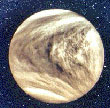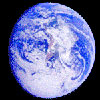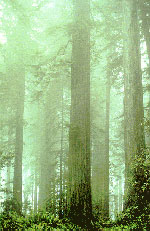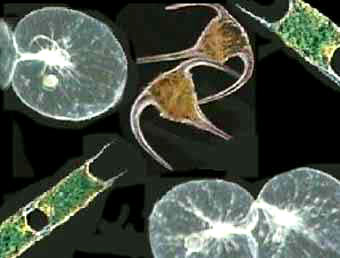|
by Sean Chamberlin from OceanOnLine.com Website
The last half of this century witnessed incredible leaps in our understanding of planet Earth.
Beyond the technological achievements, these decades have produced a substantial body of evidence in support of a revolutionary hypothesis, first posed by Alfred Wegener in the early 1900s, that the continents move around the planet, like ice cubes in a glass.
The theory of plate tectonics, as it is now known, embodies a century or more of scientific research, bringing together the efforts of oceanographers, geophysicists, climatologists, planetologists and more.
It represents to my mind
what the scientific method is all about and provides an awesome
example of how science works.
While perhaps agreeable to many an
artistic or spiritual soul, the very statement of the hypothesis
rankled some scientists. Still, two decades later,
the Gaia
Hypothesis is still with us.
Formulated by James Lovelock in the mid-1960s and published in a book in 1979, this controversial idea has spawned several interesting ideas and many new areas of research. While this hypothesis is by no means substantiated, it provides many useful lessons about the interaction of physical, chemical, geological, and biological processes on Earth.
Thus, it is
a good starting point for our study of oceanography, providing a
broad overview of the kinds of processes that will interest us
throughout the semester.
The lines and passages within the "maze" represent the
universal plan of the Creator and the path that man must follow to
seek enlightenment.
Gaia
embodies the idea of a Mother Earth, the source of the living and
non-living entities that make up the Earth. Like Kali,
Gaia was
gentle, feminine and nurturing, but also ruthlessly cruel to any who
crossed her. Note that the prefix "ge" in the words geology and
geography is taken from the Greek root for Earth.
Lovelock defines Gaia as,
Through Gaia, the
Earth sustains a kind of homeostasis, the maintenance of relatively
constant conditions.
And right before Lovelock, Lewis Thomas, a medical doctor and skilled writer, penned these words in his famous collection of essays, The Lives of a Cell:
Thomas goes even one step further when he writes:
Whether the Earth is a cell, an organism, or a super-organism is largely a matter of semantics, and a topic that I will leave to the more philosophically minded.
The key point here is the hypothesis
that the Earth acts as a single system - it is a coherent,
self-regulated, assemblage of physical, chemical, geological, and
biological forces that interact to maintain a unified whole balanced
between the input of energy from the sun and the thermal sink of
energy into space.
On the other hand, the mass of the Earth, its material possessions, are limited (except for the occasional input of mass provided as meteors strike the planet).
Thus, while energy flows
through the Earth (sun to Earth to space), matter cycles within the
Earth.
No longer can we think of man's actions in one part of the planet as independent.
Everything that happens on the planet - the deforestation/reforestation of trees, the increase/decrease of emissions of carbon dioxide, the removal or planting of croplands - all have an affect on our planet. The most difficult part of this idea is how to qualify these effects, i.e. to determine whether these effects are positive or negative. If the Earth is indeed self-regulating, then it will adjust to the impacts of man.
However, as we will see, these adjustments may act to exclude man, much as the introduction of oxygen into the atmosphere by photosynthetic bacteria acted to exclude anaerobic bacteria.
This
is the crux of the Gaia hypothesis...
Inherent in this explanation is the idea that biosphere, the atmosphere, the lithosphere and the hydrosphere are in some kind of balance - that they maintain a homeostatic condition.
This homeostasis is much like the internal maintenance of our own bodies; processes within our body insure a constant temperature, blood pH, electrochemical balance, etc. The inner workings of Gaia, therefore, can be viewed as a study of the physiology of the Earth, where the oceans and rivers are the Earth's blood, the atmosphere is the Earth's lungs, the land is the Earth's bones, and the living organisms are the Earth's senses.
Lovelock calls this the science of
geophysiology - the physiology of the Earth (or any other planet).
As part of a NASA team formed in 1965 to look for life on other planets, Lovelock was asked to propose hypotheses that would demonstrate whether life existed on a planet or not.
One of these hypotheses was the idea that gases in an atmosphere on a "dead" planet would be in chemical equilibrium, that is, all the possible chemical reactions that could have happened would have happened and the gases of the atmosphere would be relatively inert.
On the other hand, if life existed on the planet, gases in the atmosphere would not be in balance, and chemical reactions would be actively occurring.
When they looked at the gaseous composition of Mars and Venus, they saw that the atmosphere was largely composed of the generally unreactive gas carbon dioxide. According to their hypothesis, both these planets would be dead.
However, when they looked at Earth, they saw that the atmosphere was
an unusual and unstable mixture of many gases. Thus, life was
expected to be present on Earth (which we all know is true).
The fact that the gaseous composition of the Earth was not in chemical equilibrium, yet appeared to be maintained in a constant state, suggested some form of planetary regulation for the planet's atmosphere.
Lovelock initially suggested that life
itself maintained the composition of the atmosphere, but has
broadened the concept to include the whole system of the climate,
the rocks, the air, and the oceans as a self-regulating process.
Physicists define life as a system of locally reduced entropy (life is the battle against entropy). Molecular biologists view life as replicating strands of DNA that compete for survival and evolve to optimize their survival in changing surroundings. Physiologists might view life as a biochemical system that us able to use energy from external sources to grow and reproduce.
According to Lovelock, the geophysiologist sees life as a system open to the flux of matter and energy but that maintains an internal steady-state.
Redwood trees from the National and State Parks Electronic Visitor's Center
Modern biology texts often provide the best descriptions of what defines like.
Before you proceed, take a few moments to review the characteristics of living matter .
One useful
analogy that has been proposed for understanding Gaia is the
California redwood tree,
Sequoia gigantea. These trees which
stand in great groves along the northern coast of California
and elsewhere can stand as high as 300 feet and weigh as
much as 2000 tons. Some of them are more than 3000 years
old.
The wood of the trunk and the bark of the tree are dead. Only a small rim of cells along the periphery of the trunk is living. The trunk of the tree is similar to the Earth's lithosphere with a thin layer of living organisms spread across its surface. The bark, like the atmosphere, protects the living tissues, and allows for the exchange of biologically important gases, such as carbon dioxide and oxygen.
There is no doubt in my mind that a redwood tree is a living entity. Would you just call the outer layer the redwood tree and the rest of it dead wood?
The same
holds true for Gaia. While much of the Earth may be considered
"non-living", the fact that all of these non-living parts are
involved to some extent in living processes suggests that the whole
Earth is alive, just like a redwood tree.
The maintenance of this body temperature is the result of feedbacks between the brain and various organs and systems of the body. Our bodies have developed different responses to increases or decreases in our core temperature.
If it is too cold, our bodies produce heat by shivering; if it is too warm, our bodies sweat and remove heat through evaporation. Of course, humans have extended their ability to survive in extremes of temperatures by inventing clothing that insulates, heats, and even cools our bodies.
Such clothing has allowed humans to explore the
coldest waters of the polar oceans or the hottest regions of the
world's deserts.
Albedo refers to the color of a planet and its ability to absorb or reflect light.
Probably most of you have experienced the difference in temperature between a black asphalt street and a white sidewalk; the Earth's temperature regulation works in much the same way.
As you can imagine, the albedo of the Earth is not constant.
What
kinds of changes occur over the Earth's surface that would affect
the Earth's albedo?
Other factors, such as the rain shadow effect and weather fronts contribute to cloud cover over the planet.
Gephrocapsa sp, one of many species of coccolithophorids living in the ocean
Given that the oceans cover two-thirds of the Earth's surface, it stands to reason that anything that contributes to the formation of clouds over the ocean will have a major impact on the Earth's temperature.
One such mechanism proposed in the last couple decades is the release of cloud-condensation nuclei (or CCN's) by marine phytoplankton, particularly coccolithophorids.
Coccolithophorids are well-known for their beautiful calcareous skeletons that make up the White Cliffs of Dover in England.
Clouds form when water vapor in the atmosphere condenses or freezes. However, for clouds to form, a particle or "nucleus" must be present to "gather up" the water into a droplet.
These particles, called cloud-condensation nuclei, are the tiny particles in the atmosphere that lead to the formation of clouds. Water vapor condenses around these particles and clouds are formed.
One substance that can act as a CCN is dimethyl sulphide, or DMS. It has been known for quite some time that certain algae or phytoplankton (plant plankton that live in the ocean) release trace quantities of DMS.
Production of DMS by
phytoplankton may be
sufficient to cause the formation of clouds, and recent research has
been directed towards quantifying the amounts of DMS released into
the atmosphere by organisms living in the sea.
When the sun is shining brightly, phytoplankton grow rapidly (they're plants, remember?) and produce DMS, which leads to clouds.
After a while, the increase in clouds lowers the temperature of the Earth, but it also blocks the sunlight to the phytoplankton. As a result, the phytoplankton grow more slowly, less clouds are formed, and the temperature of the Earth rises.
The cycle continues to repeat in a self-regulating and
balanced manner.
Regardless of whether this mechanism bears the test of time, it does give us pause to think of how living organisms and the Earth itself may interact with each other. It should make us sit and wonder how such a mechanism evolved.
For
sure, the idea that the whole Earth - the lithosphere, atmosphere,
hydrosphere, and biosphere - works together in a harmonious fashion
has great intellectual, philosophical, and poetical appeal, if
nothing else!
We've already mentioned the maintenance of non-equilibrium conditions in the atmosphere as one characteristic of a Gaian planet.
We also looked at how organisms such as phytoplankton can
transfer chemicals such as DMS into the atmosphere and thus,
participate in the cycling of elements within the planet. Organisms
are a vital part of all chemical cycles and I would like to
introduce to you here the concept of biogeochemical cycles.
Otherwise, the whole system would run down and the Earth would be
just like the moon.
If, after
a number of decades, a large body of evidence develops that supports
the hypothesis that our planet is a living, self-regulating
organism, then the Gaia hypothesis may be upgraded to a theory, much
like the theory of gravity. Until then, Gaia is an idea that
stimulates our thinking and generates scientific research that helps
us better understand our planet and how it works.
One of the biggest criticisms against the idea
that Gaia is a "living" organism is the
inability of the planet to
reproduce. Certainly one of the hallmarks of living organisms is
their ability to replicate and pass on their genetic information to
succeeding generations. In the case of Gaia, this does not appear to
be true, or does it?
Man's exploration of space, his interest in colonizing other planets, and the large body of sci-fi literature that describes terraforming, lend strong evidence to the idea that Gaia is planning to reproduce. Imagine that man colonizes another planet. Imagine that the planet slowly begins to transform; the atmosphere changes, perhaps leading to the formation of ice caps; plants grow, creating clouds and changing the planet's albedo.
No
longer will this planet be a static, forbidden place. It will be
transformed into a place of beauty - a living, breathing, evolving
entity. This indeed is the power of Gaia, and one of the more
fascinating and compelling reasons to consider her existence!
At the end of Chapter 1 in his first book, Lovelock writes:
Update Summer 1999
Having taken a
couple courses in Systems Ecology from Dr. James Kremer, I was more
than accepting of the idea that systems have emergent properties
that cannot be discerned from their individual components. Within
that context, the Gaia Hypothesis made sense to me, perhaps more
philosophical scientific, but sense, nonetheless.
It has
also become somewhat of a theme of mine throughout all of my
oceanography classes, not so much the hypothesis, but the idea that
physical, geological, chemical and biological processes are
interdependent, something that fits quite well with Gaian Theory.
This is not uncommon in scientific work and it generally represents
a healthy and lively application of the scientific method. This
divergence of views arises as a result of the different approaches
of individual scientists and their beliefs, in the sense of their
view of what a body of evidence supports or doesn't support.
A group of geophysicists and
others came together to discuss the hypothesis, an event in itself
that helped fuel its acceptance. While there were (and still are)
many detractors, Gaia did appear to gain a toehold with general
acceptance of the idea that life at least influences planetary
processes.
The resulting oxygen holocaust, which established present-day oxygen concentrations about 2.5 billion years ago, radically changed physical, geological, chemical and biological processes on our planet. Rust is one good example of chemical alterations brought about by oxygen.
A good biological example is
the appearance of oxygen-breathing organisms, or aerobes, and the
confinement (in a figurative sense) of non-oxygen breathing
organisms, or anaerobes, to swamps and bogs and places deep in the
Earth.
This hypothesis is generally
supported by scientists today and, in fact, is probably most
responsible for stimulating continued research on Gaia. Even the
most conservative scientists agree that research on the way in which
living organisms interact with non-living processes may yield useful
information. Much of our modern-day climate research is based, to
some degree, on this idea.
This method of falsifying a hypothesis was proposed by the Austrian-born Karl Popper in a 1934 publication called Logik Der Forschung or The Logic of Scientific Discovery.
(Popper passed away in 1994 but he is still considered one of the most influential philosophers of the 20th Century. You can learn more about him by visiting the Karl Popper Website. The single largest complaint lodged against the strong Gaia hypothesis is that experiments can't be designed to refute it - or test it at all, for that matter.)
Without going into all the details, suffice it to say that those arguments are valid.
The strong Gaia hypothesis states that life creates conditions on Earth to suit itself. Life created the planet Earth, not the other way around.
As we explore the solar system and
galaxies beyond, it may one day be possible to design an experiment
to test whether life indeed manipulates planetary processes for its
own purposes or whether life is just an evolutionary processes that
occurs in response to changes in the non-living world.
|






 Imagine that!
Phytoplankton, tiny single-celled plants in the sea, have their
fingers on the Earth's thermostat!
Imagine that!
Phytoplankton, tiny single-celled plants in the sea, have their
fingers on the Earth's thermostat!